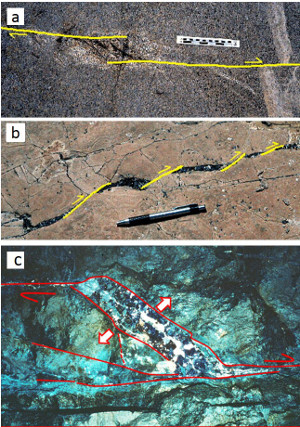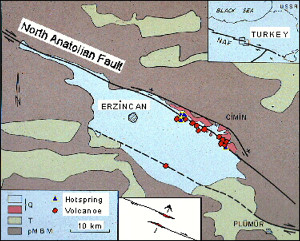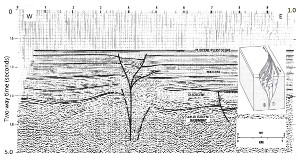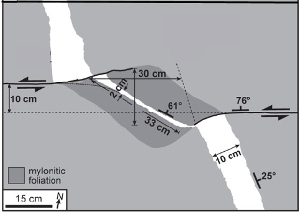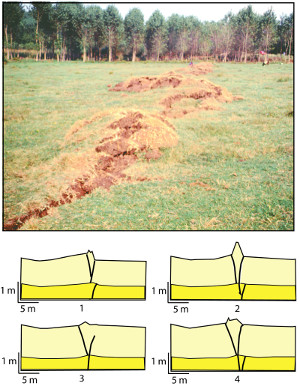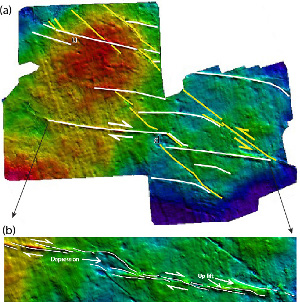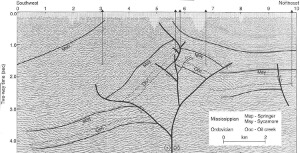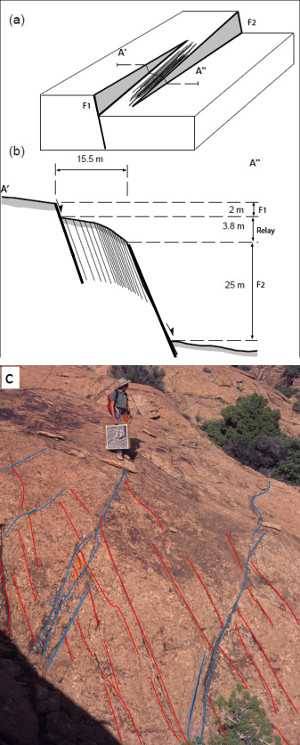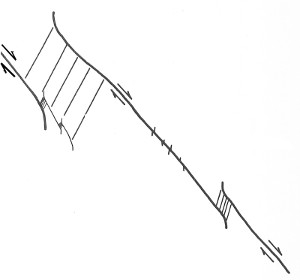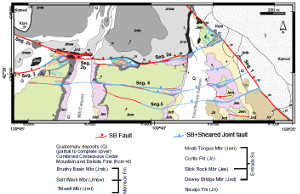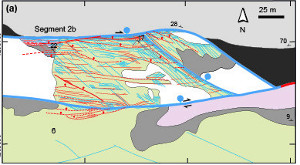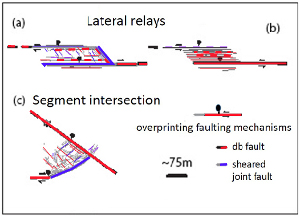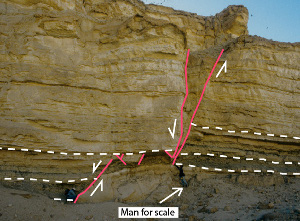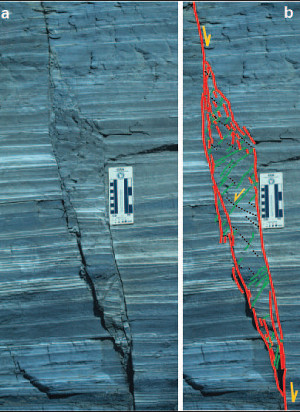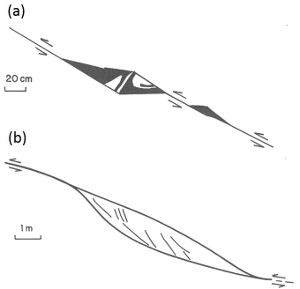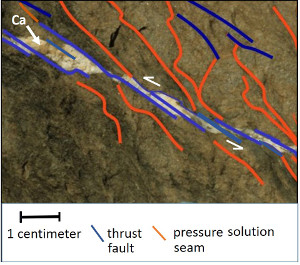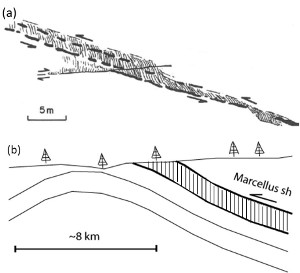| |||||||||||||||
|
|
|||||||||||||||
|
|
|||||||||||||||
| Echelon Faults | |||||||||||||||
|
Faults are made up of strands and segments in all scales, as illustrated schematically under the link, 'Components of Faults.' These are responsible for most of the complexities associated with the development of faults in rocks and regions in all sizes. In fact, the science of studying faults would be extremely dull if natural faults had a continuous planar geometry without these complexities. Segments or neighboring faults can be co-linear, but often for a good reason, they are not aligned if the closer tips of the neighboring faults are near each other. As a result, echelon patterns of neighboring faults with a right sense or a left sense of steps, or stepovers with a certain amount of fault overlap are common in nature. 'Right' and 'left' are defined in a classical way: Standing on the trace of one and facing to the other on the right-hand or left-hand side, respectively. The geometry of echelon faults and the associated steps or relays can be better quantified in terms of the spacing (the distance between the faults perpendicular to their planes or traces) and the relative position of their tips with respect to each other (see the links 'Mechanisms and Mechanics of Echelon Faults' and 'Interaction of Faults'). Neighboring fault tips are rarely aligned along a line perpendicular to their plane or trace due to the mechanical interaction between the neighboring segments, which enhances the tendency of the tips to pass each other. In most cases, neighboring faults do overlap by a certain proportion of their lengths or heights, but underlapping fault geometries also exist. These are commonly called en echelon or, in short, echelon as used in this Knowledgebase. Echelon fault geometry occurs in all major fault types, strike-slip and dip-slip or any kinematics in between although the orientation and type of accompanying structures may vary from one fault type to another. The accompanying structure types and their geometry also vary from one lithology to another or from one mechanical behavior to another. Here, an effort has been made to cover as many varieties as possible. As a rule of thumb, it is practical to keep in mind that if the sense of stepping and slip kinematics are the same, the resulting deformation at the steps or relays is extensional. The results of this type are commonly referred to as extensional or divergent steps or pull-apart structures. On the other hand, if the senses of step and slip are opposite, then they are contraction or convergent steps or push-up structures. The first part of this section deals primarily with strike-slip faults because they are easy to observe in the field and therefore have plenty of good examples. The following part will focus on dip-slip faults in various lithologies to describe a broad range of structural behaviors and products. Figure 1 includes a series of small size pull-apart structures: (a) veins filled by epidot (darker) in granitic rocks of Sierra Nevada, California; (b) rhomb-shaped dilation filled by tar in a detrital rock in coastal California, and (c) microscope view of a thin section showing a pull-apart filled by precipitated silica (quartz) and lead (galena) with a trace amount of silver from a sample from Topia Mine, Mexico. Examples of larger size pull-apart structures are also well-known. For example, Figure 2 is a map of the Erzincan pull-apart located at a right step along the right-lateral North Anatolian Fault in Turkey. Here, the structures of expression of the dilation within the basin are different: Normal faults, cinder cones, and dikes are wide spread especially along the northeastern boundary of the basin. Evidence for extensional deformation and the associated structures, particularly at the subsurface, can be better seen in seismic sections across pull-apart basins. Figure 3 shows an interpretation from rather old seismic data showing a profile across the Andaman Sea Fault in Indonesia. This type of fault patterns is commonly called a 'flower' structure in the industry; 'positive' if the faults have extensional component in a divergent step. If the deformation is of contraction or compressional type in a fault step or relay, it is known as a contraction or compressional step or relay. Figure 4 is a map showing deformation of a segment of an aplite dike located within a step between a left-stepping echelon fault pair in granodiorite of Sierra Nevada, California. The thickness of the dike outside of the step is about 10 cm, but it has been reduced to about 2 cm within the step. Here, the structure accommodating the shortening is mylonitic foliation and the deformation mechanism was proposed to be plastic or elastoplastic. Figure 5 shows a series of left-steps marked by noticeable uplift of a previously flat field along the right-lateral North Anatolian Fault rupture near Izmit during the 1999 earthquake. For an obvious reason, these are referred to as push-ups or mole-tracks in the strike-slip literature. The cross sections below the photograph are projections of possible segment geometries into the subsurface. Structural depressions associated with extension and uplifts associated with contraction are best expressed in seismic data showing horizon maps and can be used for inferring the sense of the motion along segmented faults dominated by lateral-slip component. Figures 6a and b illustrate obvious depression (d) and uplift (u) at right-step and left-step, respectively, consistent with a right-lateral interpretation of an N75W fault set in a seismic data set from Abu Dhabi. Figure 6(b) is an enlargement of one of the faults showing finer scale steps with general uplift at the stepovers. Figure 7 shows a large scale example of an uplift or push-up structure in a seismic image from the Ardmore basin, Oklahoma, which was interpreted to be a basement involved convergent step or a negative flower structure as shown by the inset diagram. Note that the nearly vertical major strike-slip fault traces are not aligned indicating that the echelon patterns also occur in down dip direction. It suffices to point out that, in this case, the geometry and kinematics of the linkage products are different than those of the strike-slip faults with lateral steps.
The next series of figures represents some select examples of dip-slip faults of dominantly normal or thrust kinematics with a variety of echelon patterns in a variety of lithologies. Figures 8a and b show a block diagram and a section, respectively, of echelon normal faults and the associated lateral relay between them in sandstone over a body of salt withdrawal at Arches National Park, Utah. The relay has been tilted by a series of shear band faults accommodating a total of about 4 m down-dropping across a distance of about 16 m between the bounding echelon faults marked by distinct slip surfaces with 2 and 25 m slip, respectively, along the scanline. Although the schematic section shows shear bands parallel the bounding faults within the ramp, there exist also shear band faults dipping in the opposite direction at normal fault relays as shown in Figure 8c. Figure 9 is a schematic diagram based on the observation of a mine shaft wall in a gold mine in South Africa. Here, in contrast to the cases in Figures 8a, b, and c, the diagonal relay fractures are joints and sheared joints. A series of more complex relay structures are well-exposed along the Moab Fault in Utah (Figure 10 and Figure 11), which is well known for its prototypical architecture. In this case, the additional complexity arises from the fact that two rather different types of failure structures occur in the Wingate and the Navajo sandstones as shear bands and sheared joints at the relays. Some of these structures and the associated deformation events show clear sequential age relationships as idealized in a simple schematic diagram in Figure 12, and may be related to a small component of shearing of opposite sense across the echelon fault segments.
Figure 13 shows a contraction relay exposed on a steep cliff offsetting a limestone-shale unit for about 2 m in a normal sense on a steep dry river bank or wadi at Hadahid region of the Gulf of Suez, Egypt. The contraction or thinning of the limestone-shale horizon was accommodated by smaller normal faults in limestone and by cleavages within the shale. Figure 14a is a photograph showing a down-dip contraction relay between echelon normal faults in the siliceous shale of the Monterey Formation. In this case, the contraction has been accommodated primarily by two sets of faults color-coded as green and black in Figure 14b.
Figure 15 to Figure 17 are examples of various relays between thrust faults of various sizes. The pull-apart structures in Figure 15a and Figure 16 are filled by precipitants, while contraction was accommodated by faults and pressure solution seams or cleavages in the units dominated by shale. | |||||||||||||||
| Reference: |
|||||||||||||||
| Antonellini, M., Aydin, A., 1995 Aydin, A., 1988 Aydin, A., Kalafat, D., 2002 Aydin, A., 2014 de Joussineau, G., Aydin, A., 2007 Harding, T.P., Lowell, J.D., 1979 Harding, T.P., Vierbuchen, R.C., Christie-Blick, N., 1985 Harris, R.A., Day, S.M., 1999 Ketin, I., 1969 McGarr, A., Pollard, D.D., Gay, N.C., Ortlepp, W.D., 1979 Nevitt, J., Pollard, D.D., Warren, J., 2014 Nickelsen, R.P., Cotter, E., 1983 Ohlmacher, G., Aydin, A., 1995 Younes, A.I., Aydin, A., 1998 |
|||||||||||||||
|
Readme | About Us | Acknowledgement | How to Cite | Terms of Use | Ⓒ Rock Fracture Knowledgebase |
|||||||||||||||
